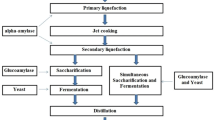Abstract
Starch samples with 0% or 30% amylose were subjected to four different liquefaction enzyme treatments (at various temperature and pH conditions) followed by simultaneous saccharification and fermentation (SSF). Resistant starch (RS) measurements were conducted for the initial starch sample, after liquefaction and after SSF. Initial RS was higher for 30% amylose starch samples (16.53 g/100 g sample) compared with 0% amylose (0.76 g/100 g sample). Higher initial RS resulted in lower conversion of starch into sugars and lower final ethanol yields. The four enzymes hydrolyzed RS, but in varying amounts. Higher temperature liquefaction hydrolyzed a larger portion of RS, resulting in higher ethanol concentrations and lower final residual solids (non-fermentables), whereas lower temperature liquefaction hydrolyzed a smaller portion of RS and resulted in lower ethanol concentrations and higher final residual solids. Decreases in resistant starch after high temperature liquefaction were 55% to 74%, whereas low temperature liquefaction decreases were 11% to 43%. For all enzyme treatments, RS content of starch samples decreased further after SSF.










Similar content being viewed by others
References
RFA (2008) Renewable fuels outlook 2008. Renewable Fuels Association. Washington, D.C. Available from: www.ethanolrfa.org.
Kwiatkowski, J. R., McAloon, A. J., Taylor, F., & Johnston, D. B. (2006). Modeling the process and costs of fuel ethanol production by the corn dry-grind process. Industrial Crops and Products, 23, 288–296.
Xie, X., Liu, Q., & Cui, S. W. (2006). Studies on the granular structure of resistant starches (type 4) from normal, high amylose and waxy corn starch citrates. Food Research International, 39, 332–341.
Haralampu, S. G. (2000). Resistant starch: a review of the physical properties and biological impact of RS3. Carbohydrate Polymers, 41, 285–292.
Berry, C. S. (1986). Resistant starch: formation and measurement of starch that survives exhaustive digestion and amylolytic enzymes during the determination of dietary fiber. Journal of Cereal Science, 4, 301–314.
Evans, A., & Thompson, D. B. (2004). Resistance to alpha-amylase digestion in four native high-amylose corn starches. Cereal Chemistry, 81, 31–37.
Jane, J. L., & Robyt, J. F. (1984). Structure studies of amylose-V complexes and retrograded amylose by action of alpha amylases, and a new method for preparing amylodextrins. Carbohydrate Research, 132, 105–118.
McCleary, B. V., & Managhan, D. A. (2002). Measurement of resistant starch. Journal of AOAC International, 85, 665–675.
Kim, J. H., Tanhehco, E. J., & Ng, P. K. W. (2006). Effect of extrusion conditions on resistant starch formation from pastry wheat flour. Food Chemistry, 99, 718–723.
Niba, L. L. (2003). Effect of storage period and temperature on resistant starch and β-glucan content in cornbread. Food Chemistry, 83, 493–498.
Sharma, V., Rausch, K. D., Tumbleson, M. E., & Singh, V. (2007). Comparison between granular starch hydrolyzing enzyme and conventional enzymes for ethanol production from maize starch with different amylose:amylopectin ratios. Starch/Stärke, 59, 549–556.
Albertyn, J., Hohmann, S., Thevelein, J. M., & Prior, B. A. (1994). Characterization of osmotic-stress response in Saccharomyces cerevisiae: osmotic stress and glucose repression regulate glycerol-3-phosphate dehydrogenase independently. Current Genetics, 25, 12–18. doi:10.1007/BF00712960.
Author information
Authors and Affiliations
Corresponding author
Rights and permissions
About this article
Cite this article
Sharma, V., Rausch, K.D., Graeber, J.V. et al. Effect of Resistant Starch on Hydrolysis and Fermentation of Corn Starch for Ethanol. Appl Biochem Biotechnol 160, 800–811 (2010). https://doi.org/10.1007/s12010-009-8651-7
Received:
Accepted:
Published:
Issue Date:
DOI: https://doi.org/10.1007/s12010-009-8651-7




